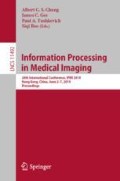Abstract
Exploring the spatial patterns and temporal dynamics of human brain activities has long been a great topic, yet development of a unified spatial-temporal model for such purpose is still challenging. To better understand brain networks based on fMRI data and inspired by the success in applying deep learning for brain encoding/decoding, we propose a novel deep sparse recurrent auto-encoder (DSRAE) in an unsupervised spatial-temporal way to learn spatial and temporal patterns of brain networks jointly. The proposed DSRAE has been validated on the publicly available human connectome project (HCP) fMRI datasets with promising results. To our best knowledge, the proposed DSRAE is among the early unified models that can extract connectome-scale spatial-temporal networks from 4D fMRI data simultaneously.
Q. Li and Q. Dong—Co-first authors.
Access this chapter
Tax calculation will be finalised at checkout
Purchases are for personal use only
References
Logothetis, N.K.: What we can do and what we cannot do with fMRI. Nature 453, 869–878 (2008)
Luiz, P.: Understanding brain networks and brain organization. Phys. Life Rev. 11, 400–435 (2014)
Friston, K.J.: Transients, metastability, and neuronal dynamics. Neuroimage 5, 164–171 (1997)
Shimony, J.S., et al.: Resting state spontaneous fluctuations in brain activity: a new paradigm for presurgical planning using fMRI 16, 578 (2009)
Smith, S.M., et al.: Temporally-independent functional modes of spontaneous brain activity. Proc. Natl. Acad. Sci. 109, 3131–3136 (2012)
Lv, J., et al.: Holistic atlases of functional networks and interactions reveal reciprocal organizational architecture of cortical function. IEEE TBME 62, 1120–1131 (2015)
Plis, S.M., et al.: Deep learning for neuroimaging: a validation study. Front. Neurosci. 8, 1–11 (2014)
Hu, X., et al.: Latent source mining in FMRI via restricted Boltzmann machine. Hum. Brain Mapp. 39, 2368–2380 (2018)
Huang, H., et al.: Modeling task fMRI data via deep convolutional autoencoder. IEEE Trans. Med. Imaging 37, 1551–1561 (2018)
Wang, H., et al.: Recognizing brain states using deep sparse recurrent neural network. IEEE Trans. Med. Imaging 38, 1058 (2018)
Jiang, X., et al.: Sparse representation of HCP grayordinate data reveals novel functional architecture of cerebral cortex. Hum. Brain Mapp. 36, 5301–5319 (2015)
Zhang, W., et al.: Experimental comparisons of sparse dictionary learning and independent component analysis for brain network inference from fMRI Data. IEEE Trans. Biomed. Eng. 66, 289 (2018)
Zhao, Yu., et al.: Modeling 4D fMRI data via spatio-temporal convolutional neural networks (ST-CNN). In: Frangi, A.F., Schnabel, J.A., Davatzikos, C., Alberola-López, C., Fichtinger, G. (eds.) MICCAI 2018. LNCS, vol. 11072, pp. 181–189. Springer, Cham (2018). https://doi.org/10.1007/978-3-030-00931-1_21
Barch, D.M., et al.: Function in the human connectome: task-fMRI and individual differences in behavior. Neuroimage 80, 169–189 (2013)
Glasser, M.F., et al.: The minimal preprocessing pipelines for the Human Connectome Project. Neuroimage 80, 105–124 (2013)
Binder, J.R., et al.: Mapping anterior temporal lobe language areas with fMRI: a multicenter normative study. Neuroimage 54, 1465–1475 (2011)
Drobyshevsky, A., Baumann, S.B., Schneider, W.: A rapid fMRI task battery for mapping of visual, motor, cognitive, and emotional function. Neuroimage 31, 732–744 (2006)
Caceres, A., et al.: Measuring fMRI reliability with the intra-class correlation coefficient Alejandro. Neuroimage 45, 758–768 (2009)
Hochreiter, S., Urgen, J.J.: Long short-term memory. Neural Comput. 9(8), 1735–1780 (1997)
Acknowledgment
Q. Li was supported by the General Program of National Natural Science Foundation of China (Grant No. 61876021), Fundamental Research Funds for the Central Universities (Grant No. 2017EYT36) and the program of China Scholarships Council (No. 201806040083). T. Liu was partially supported by National Institutes of Health (DA033393, AG042599) and National Science Foundation (IIS-1149260, CBET1302089, BCS-1439051 and DBI-1564736). We thank the HCP projects for sharing their valuable fMRI datasets.
Author information
Authors and Affiliations
Corresponding authors
Editor information
Editors and Affiliations
Rights and permissions
Copyright information
© 2019 Springer Nature Switzerland AG
About this paper
Cite this paper
Li, Q. et al. (2019). Simultaneous Spatial-Temporal Decomposition of Connectome-Scale Brain Networks by Deep Sparse Recurrent Auto-Encoders. In: Chung, A., Gee, J., Yushkevich, P., Bao, S. (eds) Information Processing in Medical Imaging. IPMI 2019. Lecture Notes in Computer Science(), vol 11492. Springer, Cham. https://doi.org/10.1007/978-3-030-20351-1_45
Download citation
DOI: https://doi.org/10.1007/978-3-030-20351-1_45
Published:
Publisher Name: Springer, Cham
Print ISBN: 978-3-030-20350-4
Online ISBN: 978-3-030-20351-1
eBook Packages: Computer ScienceComputer Science (R0)

